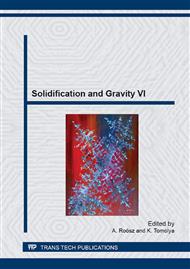[1]
X.P. Niu, B.H. Hu, I. Pinwill, H. Li: , Vacuum assisted high pressure die casting of aluminium alloys, Journal of Materials Processing Technology 105, 2000. p.119 – 127.
DOI: 10.1016/s0924-0136(00)00545-8
Google Scholar
[2]
Vacu2 Multi-Step Vacuum Process Revolutionizes Die Casting, Lowest vacuum makes for highest performance of AlSiCu alloys, 2010. www. pfeiffer-vacuum. net.
Google Scholar
[3]
Zs. LESKÓ, J. DÚL: , Effect of vacuum system on the HPD castings, Forum of PhD. Students, 2011, University of Miskolc, pp.12-24.
Google Scholar
[4]
G. BECK, F. KLEIN: , Temperaturverteilung in Druckgiessformen, Aalener Giessereisympozium 1992. pp.30-70.
Google Scholar
[5]
Zugproben für Druckguss aus Nichteisenmetallen, Beuth Verlag GmbH, Berlin, (1975).
Google Scholar
[6]
J. EMMENEGGER, FOUNDAREX VAKUUM-TECHNOLOGIE, DRUCKGUSS PRAXIS, 2009/5-6, PP. 181 – 187.
Google Scholar
[7]
M. Avalle, G. Belingardi, M.P. Cavatorta, R. Doglione: , Casting defects and fatigue strength of a de cast aluminium alloy: a comparison between standard specimens and production component, International Journal of Fatigue 24, 2002. pp.1-9.
DOI: 10.1016/s0142-1123(01)00112-8
Google Scholar
[8]
J. Asensio-Lozano, B. Suárez-Pena: , Microstructure-properties correlation of pressure die cast eutectic aluminium-silicon alloys for escaletor steps, Materials Characterization 56, 2006. pp.178-184.
DOI: 10.1016/j.matchar.2005.10.017
Google Scholar
[9]
H. Sevik, S. Can. Kkurnaz: , Propeties of alumina particular reinforced aluminium alloy produced by pressure die casting, Materials and Design 27, 2005. pp.676-683.
DOI: 10.1016/j.matdes.2005.01.006
Google Scholar
[10]
József Sándor, Jenő Dúl: , Knowledge of high pressure die casting, Publication of University of Miskolc, Mechatronics, Material Science, Miskolc, 2005. pp.69-82.
Google Scholar
[11]
B. Juhász, J. Dúl, R. Szabó: , Analysis of the thermal conditions of die-castin tool, - BKL Kohászat 2009. (142. évf. ) 5. sz. 16-21. old.
Google Scholar
[12]
A. Szombatfalvy, Gy. Fegyverneki, J. Dúl: , Optimierung der Schmelzebehandlung von AlSi-Gusslegierungen für Automotive-Anwendungen, Giesserei-Praxis 2011/11, pp.526-533. ISSN 0016-9781.
Google Scholar


